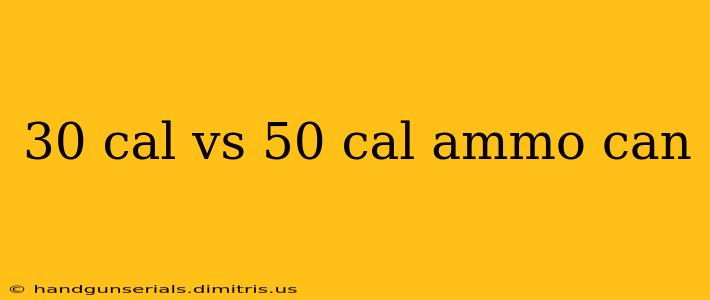Choosing the right ammo can is crucial for safely and effectively storing your supplies. This guide compares 30-caliber and 50-caliber ammo cans, highlighting their key differences to help you make an informed decision. Whether you're a seasoned collector, a prepper, or simply need robust storage solutions, understanding the nuances between these popular options is essential.
Size and Capacity: The Key Differentiator
The most significant difference between 30-caliber and 50-caliber ammo cans lies in their size and capacity. As their names suggest, these cans were originally designed to hold 30-caliber and 50-caliber ammunition, respectively. This translates to a substantial difference in storage space:
-
30 Caliber Ammo Cans: These are smaller and more compact, ideal for storing smaller items like:
- Smaller ammunition calibers (.223, 9mm, etc.)
- Gun cleaning kits
- Small tools and parts
- Electronics and other sensitive equipment (with added protection)
- Emergency supplies (first-aid kits, etc.)
-
50 Caliber Ammo Cans: Substantially larger, these offer considerably more storage volume. They're perfect for:
- Larger ammunition calibers (.50 BMG, .308, etc.)
- Larger tools and equipment
- Multiple smaller items needing consolidation
- Bulk storage of emergency food or water purification supplies
Durability and Construction: Built to Last
Both 30-caliber and 50-caliber ammo cans are renowned for their robust construction. They're typically made from steel and designed to withstand harsh conditions, offering excellent protection against:
- Moisture: The airtight seals help prevent rust and damage to stored contents.
- Impact: The sturdy steel construction protects against accidental drops and bumps.
- Dust and debris: The secure closure keeps out contaminants.
However, the 50-caliber can, due to its larger size and thicker gauge steel, generally offers superior durability and impact resistance.
Weight and Portability: Considering Practicality
The increased size and durability of the 50-caliber can come with a trade-off: weight. These cans are significantly heavier when empty and even more so when filled. While 30-caliber cans are easy to handle and transport, moving a filled 50-caliber can may require more effort. Consider your physical capabilities and the frequency of transport when making your choice.
Cost: A Factor to Consider
Generally, 50-caliber ammo cans are more expensive than 30-caliber cans, reflecting their larger size, heavier gauge steel, and increased manufacturing costs. The price difference can be significant, particularly when purchasing multiple cans.
Which Ammo Can is Right for You?
The best choice depends on your specific needs and intended use.
Choose a 30-caliber ammo can if:
- You need compact storage for smaller items.
- Portability is a primary concern.
- You're on a tighter budget.
Choose a 50-caliber ammo can if:
- You need substantial storage space for bulkier items.
- Maximum durability and protection are paramount.
- You prioritize impact resistance.
By carefully weighing these factors – size, capacity, durability, weight, and cost – you can select the ammo can that best meets your storage and organizational requirements. Remember to always prioritize safe and secure storage of your valuable items.

